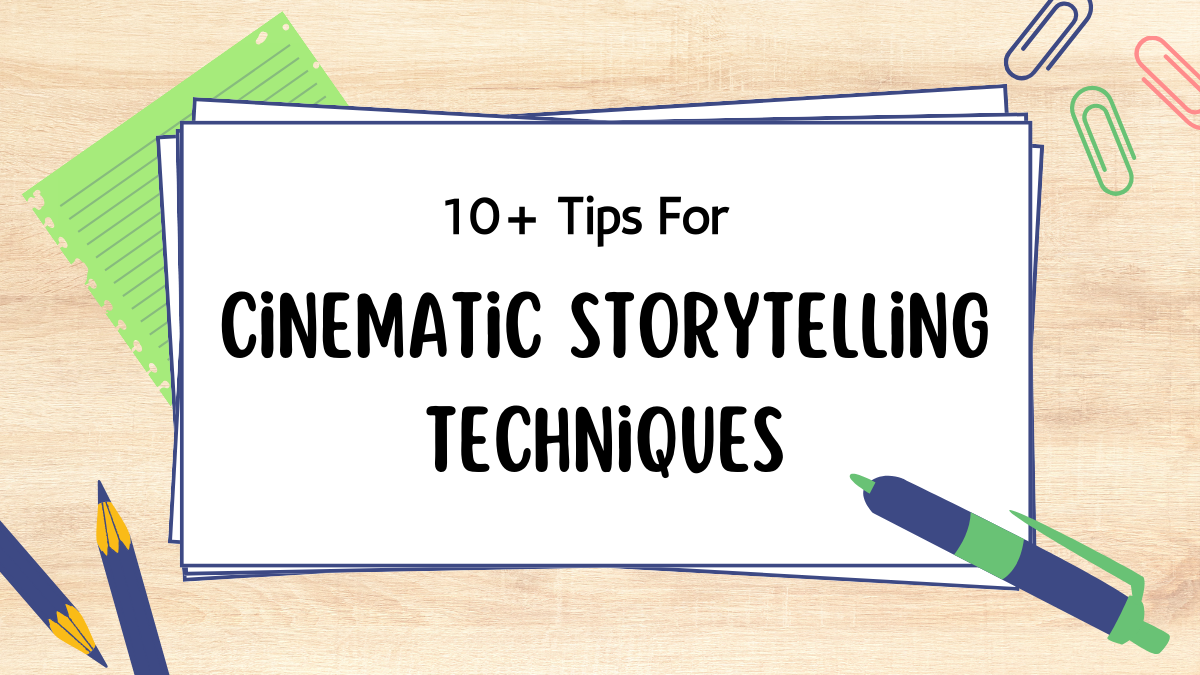
Cinematic Storytelling Techniques have the power to transport audiences to different worlds, evoke deep emotions, and leave a lasting impact. Behind every great film lies a carefully crafted story, brought to life through cinematic storytelling techniques. From visual composition to narrative structure, every aspect of filmmaking plays a crucial role in captivating audiences and delivering a memorable experience.
Table of Contents
Introduction to Cinematic Storytelling Techniques
Cinematic storytelling techniques are the art of using visual and auditory elements to convey a narrative. It goes beyond mere dialogue or plot points, encompassing everything from camera angles to sound design. In the realm of cinema, storytelling is paramount, serving as the foundation upon which films are built.
Visual Storytelling
One of the most powerful tools in a filmmaker’s arsenal is visual storytelling. Through composition, framing, and lighting, filmmakers can guide the audience’s attention and evoke specific emotions. The careful arrangement of elements within the frame can convey meaning and subtext, enriching the overall narrative.
Narrative Structure
At the heart of every story lies its structure. In cinema, narrative structure serves as the backbone of the film, providing a framework for the plot to unfold. From the traditional three-act structure to more experimental non-linear approaches, filmmakers have a range of tools at their disposal to craft compelling narratives.
Character Development
Compelling characters are essential to engaging storytelling. Through nuanced characterization and well-defined arcs, filmmakers can create protagonists and antagonists that resonate with audiences on a personal level. By exploring the complexities of human nature, filmmakers can breathe life into their characters and drive the narrative forward.
Dialogue and Sound Design
Dialogue serves as a vehicle for exposition, character development, and thematic exploration. When paired with immersive sound design, dialogue can transport audiences into the world of the film, enhancing the overall viewing experience. From subtle ambient sounds to powerful musical scores, sound design plays a crucial role in shaping the emotional landscape of a film.
Visual Effects and CGI
Advancements in cinematic storytelling techniques have revolutionized the world of filmmaking, allowing filmmakers to create breathtaking visuals and immersive worlds. When used judiciously, visual effects and CGI can enhance storytelling, bringing fantastical elements to life while maintaining a sense of realism.
Symbolism and Metaphor
Symbolism and metaphor add depth and richness to cinematic storytelling, allowing filmmakers to convey complex ideas and themes in subtle ways. By imbuing objects, locations, and even characters with symbolic meaning, filmmakers can invite audiences to interpret the story on multiple levels.
Genre-specific Techniques
Different genres of film require different storytelling techniques. From the suspenseful tension of horror films to the sweeping romance of romantic dramas, each genre presents its own unique challenges and opportunities for storytelling.
Pacing and Editing
Pacing and editing are essential elements of cinematic storytelling, influencing the rhythm and flow of the narrative. By carefully controlling the timing of scenes and the arrangement of shots, filmmakers can create tension, build suspense, and keep audiences engaged from start to finish.
Worldbuilding
Creating a compelling cinematic world requires careful attention to detail and worldbuilding. From establishing rules and boundaries to crafting rich histories and cultures, filmmakers must create immersive worlds that feel both believable and captivating.
Subtext and Foreshadowing
Subtext and foreshadowing add layers of complexity to cinematic storytelling techniques, allowing filmmakers to subtly hint at future events and themes. By planting seeds of narrative early on and weaving them throughout the story, filmmakers can reward attentive viewers with deeper insights and revelations.
Emotional Resonance
At its core, cinematic storytelling techniques are about evoking emotions and connecting with audiences on a visceral level. By crafting scenes that resonate emotionally, filmmakers can leave a lasting impact on viewers, eliciting laughter, tears, or even introspection.
Adaptation and Innovation
As filmmaking continues to evolve, so too must cinematic storytelling techniques. Filmmakers must adapt traditional storytelling methods to suit the demands of modern audiences while also pushing the boundaries of innovation and experimentation.
Case Studies
Analyzing iconic films provides valuable insights into the art of cinematic storytelling. By deconstructing the techniques used in classics such as “Citizen Kane” or “The Godfather,” filmmakers can gain a deeper understanding of what makes a story truly timeless.
Importance of Cinematic Storytelling Techniques
Cinematic storytelling techniques play a crucial role in the art of filmmaking, serving as the foundation for engaging audiences and conveying narratives effectively. Here are several key reasons why these techniques are important:
Capturing Attention:
In today’s fast-paced world, grabbing and holding the audience’s attention is paramount. Cinematic techniques such as compelling visuals, dynamic editing, and immersive sound design help to captivate viewers from the outset, drawing them into the story world.
Emotional Impact:
One of the primary goals of storytelling is to evoke emotions and resonate with audiences on a deeper level. Through techniques like camera angles, lighting, music, and performance, filmmakers can elicit a wide range of emotions, from joy and excitement to sadness and fear, fostering a more profound connection between viewers and the story.
Enhancing Narrative:
Cinematic techniques are instrumental in shaping the narrative structure and pacing of a film. Effective use of techniques like foreshadowing, flashback, and montage can enrich storytelling by providing context, building tension, or highlighting thematic elements, ultimately contributing to a more cohesive and engaging narrative experience.
Visual Communication:
Film is a visual medium, and cinematic techniques serve as the language through which stories are told on screen. Visual elements such as composition, color palette, and visual effects communicate information, mood, and subtext, allowing filmmakers to convey complex ideas and themes without relying solely on dialogue or exposition.
Creating Atmosphere:
Cinematic techniques play a vital role in establishing the atmosphere and tone of a film. Whether it’s through the use of lighting to create a sense of mystery, or sound design to evoke a feeling of suspense, these techniques help to immerse viewers in the world of the story, enhancing their overall viewing experience.
Crafting Memorable Moments:
Some of the most iconic moments in cinema are made possible through the skilled use of cinematic techniques. Whether it’s a breathtaking action sequence, a poignant character revelation, or a visually stunning set piece, these moments stay with audiences long after the credits roll, leaving a lasting impression and contributing to the cultural significance of the film.
Future Growth in Cinematic Storytelling Techniques
Certainly! The future of cinematic storytelling techniques holds immense potential for innovation and evolution. Here are some trends and advancements that may shape the landscape:
Virtual Reality (VR) and Augmented Reality (AR):
As VR and AR technologies become more accessible and sophisticated, filmmakers can immerse audiences in entirely new narrative experiences. Viewers could interact with characters and environments, blurring the lines between traditional storytelling and interactive gaming.
Interactive Narrative Experiences:
Building upon the concept of “choose your own adventure” stories, interactive narratives allow viewers to influence the plot’s direction. This form of storytelling provides a personalized experience, enhancing engagement and replay value.
AI-Generated Content:
Artificial intelligence (AI) has the potential to assist filmmakers in various aspects of production, from scriptwriting to editing. AI algorithms can analyze audience preferences and create tailored narratives, leading to more targeted and compelling storytelling.
Mixed Media Integration:
Filmmakers may increasingly integrate different forms of media, such as animation, live-action footage, and graphic design, to create visually stunning and multifaceted narratives. This blending of mediums can enhance storytelling depth and creativity.
Immersive Sound Design:
Advanced sound technologies, including spatial audio and ambisonics, can further immerse audiences in cinematic worlds. Soundscapes tailored to individual scenes can evoke emotions and enhance storytelling impact.
Environmental Storytelling:
With the rise of location-based entertainment and interactive installations, filmmakers can create narratives that extend beyond the screen. Audiences may explore physical spaces while uncovering elements of the story, blurring the boundaries between fiction and reality.
Real-Time Rendering:
The use of real-time rendering engines enables filmmakers to create high-quality visuals with greater efficiency and flexibility. This technology allows for dynamic changes during production, empowering directors to iterate and experiment more freely.
Experimental Narrative Structures:
Filmmakers may push the boundaries of traditional narrative structures, incorporating nonlinear storytelling, parallel storylines, and other unconventional techniques. This approach challenges audiences to engage with narratives in new and thought-provoking ways.
Cross-Platform Storytelling:
As audiences consume content across various platforms and devices, filmmakers can explore interconnected storytelling experiences. Transmedia narratives spanning films, TV shows, games, and social media platforms offer audiences deeper engagement and immersion.
Ethical and Socially Conscious Storytelling :
In an increasingly interconnected world, filmmakers have the opportunity to address pressing social issues and explore ethical dilemmas through their storytelling. Thought-provoking narratives can inspire empathy, drive social change, and foster meaningful discussions.
Overall, the future of cinematic storytelling techniques is likely to be characterized by innovation, interactivity, and a continued emphasis on captivating and emotionally resonant narratives. As technology continues to evolve, filmmakers will have unprecedented tools at their disposal to push the boundaries of storytelling and create truly unforgettable cinematic experiences.
Conclusion
In conclusion, mastering cinematic storytelling techniques is essential for any filmmaker looking to create impactful and memorable films. By understanding the intricacies of visual composition, narrative structure, and character development, filmmakers can captivate audiences and leave a lasting legacy in the world of cinema.
cinematic storytelling techniques are indispensable tools for filmmakers, enabling them to captivate audiences, evoke emotions, enhance narratives, communicate visually, create atmosphere, and craft memorable cinematic moments. Mastering these techniques allows filmmakers to realize their creative vision and deliver impactful storytelling experiences that resonate with audiences around the world.
Visit Website :- guest post buy
Also Visit :- Telegram
What role does symbolism play in cinematic storytelling techniques?
Ans. Symbolism adds depth and complexity to cinematic narratives, allowing filmmakers to convey abstract ideas and themes in concrete terms.
How does pacing affect the viewer’s experience of a film?
Ans. Pacing influences the rhythm and flow of a film, shaping the audience’s emotional engagement and overall enjoyment of the viewing experience.
What are some examples of innovative storytelling techniques in recent films?
Ans. Recent films like “Inception” and “Birdman” have pushed the boundaries of traditional storytelling, employing innovative techniques such as non-linear narratives and single-take sequences.
Why is character development crucial in cinematic storytelling?
Ans. Compelling characters drive the narrative forward and create emotional investment for the audience, making character development essential to effective storytelling.
How do filmmakers balance practical effects with CGI in modern cinema?
Ans. Filmmakers often use a combination of practical effects and CGI to achieve the desired visual impact while maintaining a sense of realism and immersion.





